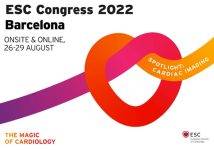Benefits of abbreviated antiaggregant treatment in high bleeding risk patients. Dual antiplatelet therapy (DAPT), established by different guidelines, reduces the risk of ischemic events at the expense of increased bleeding. This habitual APT strategy cannot be applied to patients at high risk of bleeding, which is why this populations are treated with shorter DAPT schemes…
ESC 2022 | Should We Follow-Up with Functional Testing in High-Risk Patients after CTA?
While the need for repeat cinecoronary angiography after transluminal coronary angioplasty (TCA) has decreased with the use of drug-eluting stents and improved medical treatment, patients still present ischemic recurrence or cardiovascular events at follow-up. Using a functional test at follow-up after TCA or myocardial revascularization (CMR) is a frequent practice in our context. This is…
High Risk of Bleeding after PCI: More Evidence for Short DAPT
Dual antiaggregation therapy (DAPT) with ASA and P2Y12 during 6 to 12 months is the indicated strategy after DES stenting to reduce ischemic events. However, in patients with elevated risk of bleeding (HBR) guideline and expert recommendations is 1-6 months, since there is plenty of evidence in favor, except for a randomized study, the MASTER…
Two Safe Stents at Two Years in High Bleeding Risk
There is a consistent number of patients presenting high risk of bleeding. In this context, receiving dual antiplatelet therapy (DAPT) for 12 months would not be advisable. Even though the European and American guidelines recommend 1 to 6 months for chronic and acute syndromes in this group, these are often complex PCI cases, which makes…
TRAPEUR Registry: Thrombus Trapping with Left Atrial Appendage Closure Device
Left atrial appendage closure (LAAC) devices are a good alternative for the prevention of systemic thromboembolism in patients with non-valvular atrial fibrillation (AF) and high risk of bleeding or those with anticoagulation contraindication. According to PRAGUE-17 outcomes, at 4 years, LAAC resulted non-inferior to direct anticoagulation in the prevention of cardiovascular, neurological, and bleeding events. …
Post-PCI Ticagrelor Monotherapy in High-Risk Bleeding
In patients at high risk of bleeding undergoing coronary PCI and after completing 3-month DAPT with no events, you may discontinue aspirin and follow up with ticagrelor monotherapy. This will significantly reduce bleeding without increasing ischemic events. With this strategy, the greater the risk of bleeding, the greater the absolute reduction of bleeding. Patients at…
XIENCE SHORT DAPT | Ideal DAPT Period for Patients at High Risk of Bleeding
In patients at high risk of bleeding undergoing coronary stenting with a Xience stent, 1-to-3-month DAPT period resulted non-inferior to a 6-to-12-month period in terms of ischemic events, and this could be associated to a lower rate of major bleeding and lower stent thrombosis incidence. There is no longer an indication for conventional stents in…
ESC 2021 | MASTER DAPT: Dual Antiplatelet Therapy After Coronary Angioplasty in Patients at High Bleeding Risk
Courtesy of Dr. José Álvarez. In patients at high bleeding risk with drug-eluting stents, the duration of dual antiplatelet therapy has been subjected to ongoing review. Guidelines from the European Society of Cardiology (ESC) and the American College of Cardiology (ACC) suggest shortening this treatment to a maximum of three to six months (Class IIb).…
Watch again our Webinar on Short Dual Therapy in Patients with High Bleeding Risk
Watch again our Webinar on “Short Dual Therapy in Patients with High Bleeding Risk” on our Youtube account. The event was held on 12/08/2020 and had the participation of more than 200 people and the support of ABBOTT. What things will I learn if I watch this video? 04:02 | Innovation: Short Dual Therapy in…
Onyx ONE: More Options for Patients at High Risk for Bleeding
Since November 2015, when the LEADERS FREE was published in NEJM, polymer-free drug coated stents had undoubtedly been the best treatment for patients at high risk of bleeding. The benefit was owed to the safety and efficacy of the polymer-free biolimus coated stent (also called umirolimus) vs. bare metal stents in the context of just…









